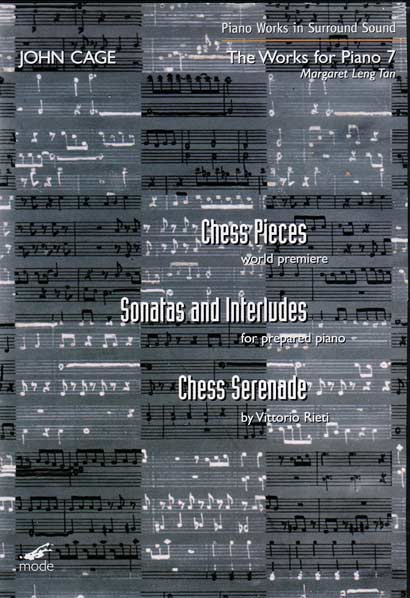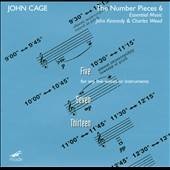|
 Cage & Rieti Cage & Rieti
John CAGE: Volume 34:
The Piano Works 7
Chess Pieces (1944, world premiere)
Sonatas and Interludes
Vittorio RIETI: Chess Serenade
includes 5 films on John Cage - Documentaries with Ms. Tan: Cage's Prepared Piano & Cage's Box of Preparations;
CAGE: Music/Art/Chess [with Larry List, on Cage's "score-painting"
of Chess Pieces and his involvement in 1944 with the surrealists in The Imagery of Chess exhibition.
Margaret Leng Tan (piano & prepared piano)
DVD Video (mode 158)
This is a quite extraordinary production, of which I have been privileged to receive a now rare disc.
Brian Brandt has achieved a massive contribution to Cage studies. I was familiar with Margaret Leng Tan's fringe activities from a toy piano recital at The Warehouse in London; a surreal experience and hard to take seriously...
Her devotion to John Cage and his music for prepared piano is impressive and the interviews here riveting and illuminating. I have long enjoyed the Sonatas and Interludes for prepared piano and have CDs including Joanne MacGregor's which launched her own label. See also Daryl Runswick on Cage in his extensive review for MusicalPointers of Rzewski's writings.
Start with the interview about Leng Tan's deciphering and bring to performance the mysterious Chess Pieces score/painting (q.v. cover image illustrated larger than usual) in a superbly filmed and edited interview with Larry List - it looks spontaneous, though the topics were probably worked out in advance. You will almost certainly become hooked by her enthusiasm and become ready to spend time with her as she laboriously prepares the piano for her performance of Sonatas and Interludes recorded here, accompanied visually by pages of the score.
Click onto Mode DVD & DVD-AUdio to see their mission statement;
in summary "Mode's goal with the DVD is to utilize the format for its greatest strengths:
the ability to present multi-channel compositions in surround-sound;
the ability to present music in high-definition 24-bit sound for outstanding sonics;
we strive to include extras with each DVD in the form of interviews or other features whenever possible;
all Mode DVDs are playable on any DVD player (unless otherwise noted)."
Explore and enjoy !
Peter Grahame Woolf
Cage The Number Pieces 6
 Mode 239 Mode 239
I love Mode, but can't go all the way with them, though I try...
This re-released CD was for us unlistenable to. Its essay by John Kennedy outlines the aesthetic of what, surely, will only remain a footnote in musical history?
Best is the elegant cover image...
PGW
Other Mode releases reviewed on Musical Pointers:
Berio SequenzasI-XIV
Xenakis Electronic1&2
Dallapiccola, Petrassi, Henze & Cappello
Czernowin Shu Hai
Earle Brown
More about Chess Pieces :
Cage, John 1943. Chess Pieces.
In the John Cage Music Manuscript Collection of The New York Public Library for the Performing Arts there is a folder of 13 pages of handwritten music (plus one cover page) by John Cage that contains a work titled Chess Pieces (call number: JPB 95-3 Folder 109). This work (which might be for piano) appears to be of the form: aabbddeefga agfeeddbbaa. Note that the form of the second half of the piece is a mirror image of the first half. Eleven 12-bar sections have been written. Perhaps these eleven sections are to be used as the eleven sections of the first half of the piece. Mirror images are also used for smaller structures. For example, the 12 bars of the first two "a" sections are grouped as 3 bars, followed by 4 bars, followed by 5 bars (i.e. 12=3+4+5). The 12 bars of the first "b" section are grouped as 5 bars, followed by 4 bars, followed by 3 bars (i.e. 12=5+4+3).
This piece may be unfinished. It is unclear whether or not Cage intended to write eleven more sections for the second half of the piece or if the eleven sections that have been written are to be played in reverse order for the second half.
It is not known how this piece is related to chess. There are many open questions:
Why is the structure of the piece based upon mirror images? Do these mirror images represent the mirror image of the arrangement of white and black pieces at the beginning of a game?
Why are there 6 different section types (i.e. a, b, d, e, f, and g)? Is there a one-to-one correspondence between the section types and the 6 chessman types (e.g. a=pawn, b=rook, etc.)? Or, should the form be written as a2b2d2e2f1g1a1? This representation of the form suggests that the form may have been derived from algebraic notation of a particular game.
Why are there 11 sections in each half of the piece?
Why do all sections consist of 12 bars?
How were the pitches selected for this piece?
Addendum: John Cage created a painting titled Chess Pieces that contains a music score, which is distributed over the 64 squares of a chessboard. This work was presented in an exhibition at the Noguchi Museum titled The Imagery of Chess Revisited (October 21, 2005 - April 16, 2006); this was an expanded version of a 1944 exhibition organized by Marcel Duchamp and Max Ernst at the Julien Levy Gallery. The entry in the checklist for the exhibition at the Noguchi Museum describes the work as follows:
Cage, John 1968. Reunion.
This piece was performed in 1968 at Ryerson Polytechnic in Toronto. Lowell Cross constructed a chess board equipped with photoreceptors that served as a gating mechanism to transmit or cut off sound produced by other musicians and to control lights. John Cage and Marcel Duchamp played a game of chess. Other participants included Teeny Duchamp, David Tudor, Gordon Mumma, and David Behrman. The book Marcel Duchamp and John Cage by Shigeko Kubota (1970) contains photographs and a recording of this performance.
|



